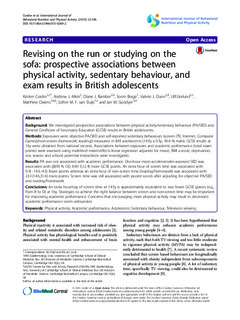| dc.contributor.author | Corder, Kirsten | |
| dc.contributor.author | Atkin, Andrew J. | |
| dc.contributor.author | Bamber, Diane J. | |
| dc.contributor.author | Brage, Søren | |
| dc.contributor.author | Dunn, Valerie J. | |
| dc.contributor.author | Ekelund, Ulf | |
| dc.contributor.author | Owens, Matthew | |
| dc.contributor.author | van Sluijs, Esther M.F. | |
| dc.contributor.author | Goodyer, Ian M. | |
| dc.date.accessioned | 2016-04-06T07:46:21Z | |
| dc.date.available | 2016-04-06T07:46:21Z | |
| dc.date.issued | 2015-09-04 | |
| dc.identifier.citation | International Journal of Behavioral Nutrition and Physical Activity. 2015,12, 106 | nb_NO |
| dc.identifier.uri | http://hdl.handle.net/11250/2384122 | |
| dc.description | © 2015 Corder et al. Open Access This article is distributed under the terms of the Creative Commons Attribution 4.0
International License (http://creativecommons.org/licenses/by/4.0/), which permits unrestricted use, distribution, and
reproduction in any medium, provided you give appropriate credit to the original author(s) and the source, provide a link to
the Creative Commons license, and indicate if changes were made. The Creative Commons Public Domain Dedication waiver
(http://creativecommons.org/publicdomain/zero/1.0/) applies to the data made available in this article, unless otherwise stated. | nb_NO |
| dc.description.abstract | Background: We investigated prospective associations between physical activity/sedentary behaviour (PA/SED) and
General Certificate of Secondary Education (GCSE) results in British adolescents.
Methods: Exposures were objective PA/SED and self-reported sedentary behaviours (screen (TV, Internet, Computer
Games)/non-screen (homework, reading)) measured in 845 adolescents (14·5y ± 0·5y; 43·6 % male). GCSE results at
16y were obtained from national records. Associations between exposures and academic performance (total exam
points) were assessed using multilevel mixed-effects linear regression adjusted for mood, BMI z-score, deprivation,
sex, season and school; potential interactions were investigated.
Results: PA was not associated with academic performance. One-hour more accelerometer-assessed SED was
associated with (β(95 % CI)) 6·9(1·5,12·4) more GCSE points. An extra hour of screen time was associated with
9.3(−14·3,-4·3) fewer points whereas an extra hour of non-screen time (reading/homework) was associated with
23·1(14·6,31·6) more points. Screen time was still associated with poorer scores after adjusting for objective PA/SED
and reading/homework.
Conclusions: An extra hour/day of screen time at 14·5y is approximately equivalent to two fewer GCSE grades (e.g.,
from B to D) at 16y. Strategies to achieve the right balance between screen and non-screen time may be important
for improving academic performance. Concerns that encouraging more physical activity may result in decreased
academic performance seem unfounded. | nb_NO |
| dc.language.iso | eng | nb_NO |
| dc.publisher | BioMed Central | nb_NO |
| dc.subject | physical activity | nb_NO |
| dc.subject | academic performance | nb_NO |
| dc.subject | adolescent | nb_NO |
| dc.subject | sedentary behaviour | nb_NO |
| dc.subject | television viewing | nb_NO |
| dc.title | Revising on the run or studying on the sofa: prospective associations between physical activity, sedentary behaviour, and exam results in British adolescents. | nb_NO |
| dc.type | Journal article | nb_NO |
| dc.type | Peer reviewed | nb_NO |
| dc.subject.nsi | VDP::Social science: 200 | nb_NO |
| dc.subject.nsi | VDP::Social science: 200::Social science in sports: 330 | nb_NO |
| dc.subject.nsi | VDP::Medical disciplines: 700 | nb_NO |
| dc.subject.nsi | VDP::Medical disciplines: 700::Sports medicine: 850 | nb_NO |
| dc.source.journal | International Journal of Behavioral Nutrition and Physical Activity | nb_NO |
| dc.identifier.doi | 10.1186/s12966-015-0269-2 | |
| dc.description.localcode | Seksjon for idrettsmedisinske fag / Department of Sports Medicine | nb_NO |
